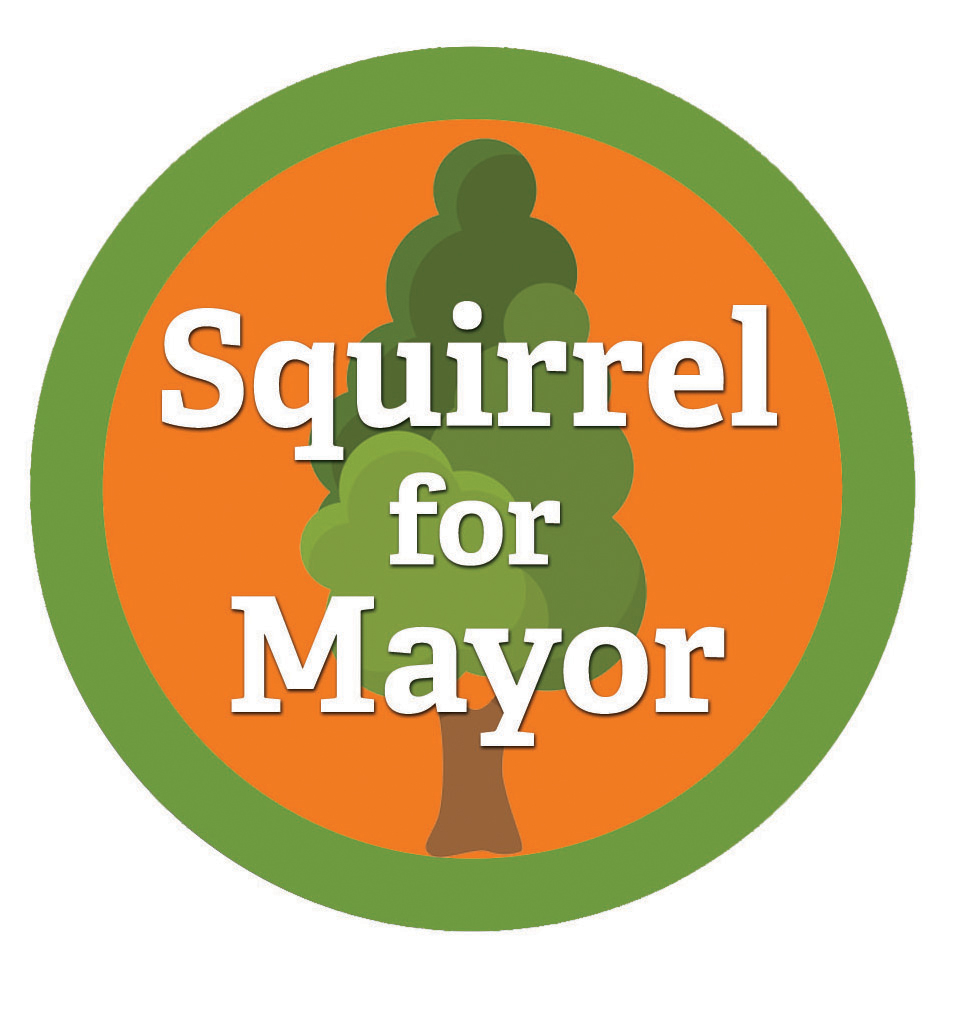Squirrel for Mayor is research-creation project that combines arts-based methodologies and community engagement to examine the increasing concerns for urban forest and tree health, and the role of public participation in successful urban forest governance.
The role of Squirrel for Mayor is inspired by Vancouver artist Vincent Trasov who assumed the persona of the well-known Planters product logo, Mr. Peanut, as the framework for an ongoing performance art project. Perhaps his most broadly public project was the Mr. Peanut Campaign for Mayor in 1974 that he devised with fellow artist John Mitchell. Mr. Peanut registered as a candidate for Mayor of Vancouver in the civic elections and attended campaign debates and meetings, interacted with the public, and gave press interviews. Photographs and documentation is in the Collection of the Morris and Helen Belkin Art Gallery Archives.
The inaugural event attended by Squirrel for Mayor was at “A Rally to Save the Centennial Sequoia,” planned by “Friends of Centennial Square,” a group of residents from the City of Victoria. The rally was aimed at protesting the City Council’s decision to remove a mature sequoia tree to facilitate a redesign of the square. Over time, the Sequoia tree has come to symbolize more than merely the act of cutting down a single tree; it now serves as a reflection of insufficient transparency and, arguably, indicators of moral hazard, within municipal governance.
Squirrel for Mayor was at the Victoria Airport with the Garry Oak Meadow Preservation team and Terra Remote Sensing to launch a Bell 206B3 Jet Ranger, equipped with a Phase One IXM-100 camera for aerial data acquisition to perform Garry oak species detection in developing a new approach to mapping Garry oak species presence using LiDAR and geoAI. By conducting species-specific detection analysis to form a species composition baseline, the project can enable future analysis opportunities that are Garry oak-specific. LiDAR was flown over the City of Victoria and the District of Saanich’s urban containment boundary. The goal of the project is to provide data to interested parties (e.g., environmental non-profits, researchers, community scientists, municipal staff, etc.), providing them with a new high bar in remote sensing data quality to innovate on the analysis front.
Urban Forest Governance.
British Columbia currently lacks legislation to safeguard urban forests, a concern that has become increasingly pressing in 2025. Many municipalities, including the City of Victoria, are facing new provincial regulations (Bills 44, 46, 47 of 2023, Bill 18 of 2024, and Bills 13, 14, 15 of 2025) that impose restrictions on public hearings regarding rezonings (Times Colonist). These measures effectively diminish public oversight and delegate decision-making authority to municipal staff, often to a single individual. For instance, Bill 44 alters the local government land use planning framework, thereby reducing or eliminating public hearings that previously facilitated greater tree retention through community input. Concurrently, numerous municipalities lack the capacity for environmental monitoring, including essential mapping and inventories of at-risk areas.
Trees and other vegetation play a crucial role in absorbing rainwater and stormwater, thereby mitigating flooding and property damage associated with climate change-related precipitation events. A robust, mature tree canopy offers vital shade, while saplings planted to replace these mature trees require decades to reach similar dimensions. To effectively protect the urban tree canopy, factors such as root space, soil volume, and setbacks must be carefully considered during development proposals.
Notably, over 75% of the urban forest exists on private land within the regional urban containment boundary. Recent updates to municipal and provincial land use regulations have significantly stimulated community engagement in urban forestry, leading to heightened awareness among citizens regarding local governance and the management of urban forests.
Where is this project located.
This website shares content related to urban forest management of Čaŋēɫč (lək̓ʷəŋən) or ĆEṈ¸IȽĆ (SENĆOŦEN) or p’hwulhp (HUL’Q’UMI’NUM’) also known as Garry oak (scientific name: Quercus garryana) and the associated ecosystem (Kwetlal or ḰȽO,EL). This includes native and non native species as outlined in municipal urban forest master plans.
Starting with data from the lək̓ʷəŋən territory, known today as the Songhees and Kosapsom Nations and we will soon add data from the W̱ SÁNEĆ region encompassing the five local communities: BO,ḰE,ĆEN (Pauquachin), MÁLEXEȽ (Malahat), W̱ JOȽEȽP (Tsartlip), W̱ ,SIKEM (Tseycum), and S,ȾAUTW̱ (Tsawout).
